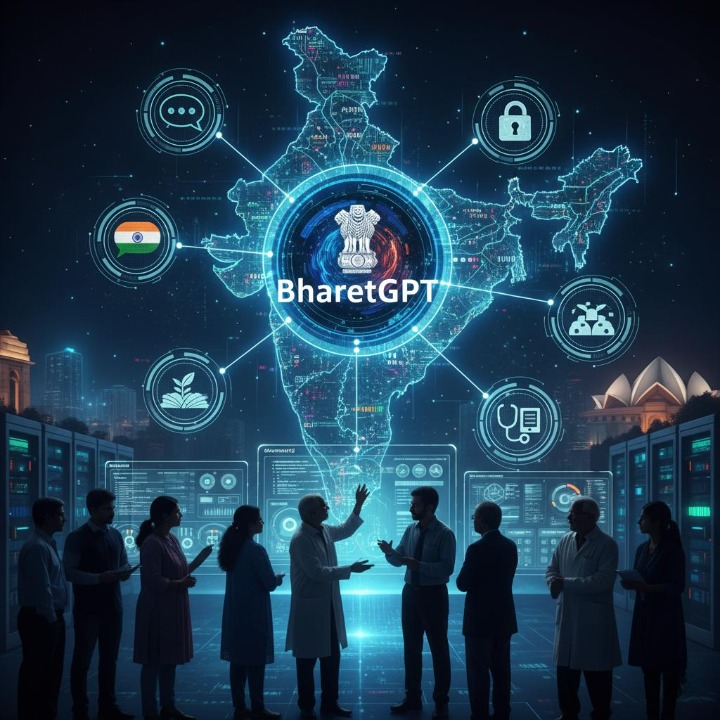Introduction
In recent years, India has been steadily transforming itself from a service‑outsourcing country into a hub of innovation and technology. One of the keystones of this transformation is the effort to build homegrown, sovereign AI systems that understand Indian languages, culture, and context. BharatGPT (or similarly India‑centric AI models) signal this ambition - a move away from relying purely on global models and toward AI “for Bharat, by Bharat.”
What is BharatGPT / Indigenous AI for India
BharatGPT is a generative AI / large language model (LLM) developed by CoRover.ai, designed specifically for Indian use cases.
- It supports voice and text modalities, in 14+ Indian languages for voice and 22+ languages for text.
- Data remains in India (data residency), fine‑tuning to Indian context, integration with local systems, multilingual support.
- It is aligned with India’s national vision of “Make AI in India, Make AI work for India.”
Another major project is BharatGen, which is being developed as an open, multilingual LLM to rival global models but tailored to Indian languages and ethics. BharatGen is a consortium effort involving government support, research institutions, and private players. For example, IBM has announced collaboration with BharatGen to accelerate AI adoption in India, leveraging Indic LLMs. BharatGen aims to create multimodal models (text, vision, etc.), support underserved languages, and provide open access (weights) for innovation.
Other models / projects in Indian AI space include Krutrim LLM, transliteration benchmarks, and datasets addressing bias in Indian contexts.
Why BharatGPT / Indigenous AI Matters
1. Linguistic Inclusivity & Cultural Context: India is multilingual with dozens of languages and dialects. Global models underperform here, while BharatGPT is designed for this context.
2. Data Sovereignty, Privacy & Compliance: Ensures data residency within India, lowering risks and adhering to regulations.
3. Economic / Development Impact: AI adoption in India is projected to add USD 500–600 billion to GDP by 2035. Indigenous AI boosts startups, research jobs, and innovation tailored to Indian problems.
4. Ethical, Bias & Representation Control: Helps mitigate caste, religious, and cultural biases in AI outputs.
5. Strategic / Geopolitical Independence: Building sovereign AI capacity strengthens national security and independence.
Challenges & Roadblocks
- High computational / infrastructure costs
- Data quality and diversity issues
- Open vs proprietary tradeoffs
- Bias, safety & governance challenges
- Limited talent and research ecosystem
- Adoption and trust issues
Use Cases / Applications
1. Government & Public Services: Citizen chatbots, translation tools, digital inclusion.
2. Education: Multilingual tutoring, adaptive learning.
3. Healthcare: Local language conversational agents, telemedicine.
4. Agriculture: AI advisors for farmers in regional languages.
5. Business: CRM/ERP chatbots, automation for SMEs.
6. Language & Culture: Transliteration, regional voice assistants.
Rival Models / Comparative Landscape
- Global models perform poorly on Indian languages.
- Krutrim LLM: A multilingual foundational model.
- BharatGen: Open access Indic LLM.
- Benchmarks and bias datasets advancing the field.
Future Roadmap & What to Watch
- Expanded language coverage
- Multimodal AI (vision, speech, video + text)
- Federated / On-device AI
- Hybrid global + local AI
- Stronger governance frameworks
- Open ecosystem collaboration
- Large-scale adoption by government & institutions
Conclusion
The rise of BharatGPT (and other Indian AI efforts) is more than a technological gamble - it’s a vision for AI that understands India deeply.
If successful, this could unlock inclusive growth, digital sovereignty, and innovation tailored to Bharat’s needs. While challenges remain, momentum from government, academia, and industry suggests India is on track to shape its AI future.




